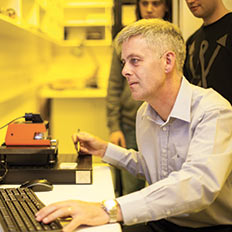
Understanding what it would take to effectively cloak an object and make it invisible may sound fanciful, but the lessons learned along the way are likely to feed into other areas of technology.
Transformation optics is a relatively new field, initiated in 2006 when researchers in the UK and US developed a cloaking device, which cloaked an area about 2.5cm in diameter in the microwave light spectrum.
Cloaking relies on metamaterials, small antenna-like resonators that effectively work like a lens or prism, directing the light around the object then sending it on in the direction it was going as if nothing was there.
Although the proof of principle has been provided, Dr Robert Thompson (Mathematics) has been awarded a three-year Fast-Start grant from the Marsden Fund to develop better mathematical tools for those designing metamaterial-based devices.
"Transformation optics is basically developing a set of tools that engineers in the future will be able to use to design anything that involves electricity, magnetism and light – almost everything in modern society from cell phones to computer parts."
"The basic theory of transformation optics is a great starting point, but it suffers some deficiencies," he explains. "There are engineering challenges to creating materials that can do the things we want to do, and the real world materials we have to work with are not completely described by the basic theory."
For example, he says, the arrays of antennas that manipulate the light have small metal elements in them. This sets up weak currents as the light goes by, creating a loss of energy through heat.
"This and a lot of other real behaviours of real materials are not accounted for in the basic theory. That means the question becomes how can you extend the basic theory to incorporate all these other real behaviours – and that's what I am primarily looking at," says Thompson.
Despite the science-fiction-like concept, the potential applications of this knowledge are very much real world – in a seemingly simple thing such as an antenna.
"Transformation optics is basically developing a set of tools that engineers in the future will be able to use to design anything that involves electricity, magnetism and light – almost everything in modern society from cell phones to computer parts."
"Everything that involves wireless communications has an antenna. It may lead to making smaller, more powerful antennas or to make them to a particular shape that you need."
Thompson's research involves a close collaboration with Professor Steve Cummer at Duke University, US, who is his associate investigator.
Superlens possibilities

Professor Richard Blaikie: "… it is a fascinating and fantastic idea that you could potentially have a microscope that has unlimited resolving power."
Deputy Vice Chancellor (Research and Enterprise) Professor Richard Blaikie (Physics) is taking the use of light-bending metamaterials in a different direction.
He is building on the pioneering work of Professor Sir John Pendry at Imperial College of London, a key player in theoretical research in cloaking and transformation optics research.
In 2000 Pendry's seminal paper on negative refraction – where light is bent back on itself – suggested that a material able to do that would make a perfect lens.
This would require "nanophotonics" one of Blaikie's areas of research, in which light is controlled at scales much smaller than its wavelength.
"Visible light microscopes are limited by the wave nature of light. We can see amazing things at the cellular and sub-cellular levels, but we can't see the molecules within the cells. There are a lot of things we would like to see that we still can't see, so a concept that might offer unlimited resolutions in light imaging is very compelling."
Blaikie's own research using a simple layer of silver to create a superlens showed the concept had possibilities, but there are also roadblocks.
"Our silver superlens gave us good resolution, but the fidelity was not that great – they were quite fuzzy images. This was because very small imperfections in the material created disproportionate imperfections in the imaging."
However, the research had, at least, shown the almost atomic-level precision that would be required for producing practical superlenses.
Blaikie says the research also has relevance to the light etching of computer chips, but adds that the emphasis is on scientific discovery.
"Of course, we would like to see the work applied, but we are not only doing it to provide the best pathway to new products. We're doing it because it is a fascinating and fantastic idea that you could potentially have a microscope that has unlimited resolving power."
Funding
Dr Robert Thompson- Marsden Fund
- Marsden Fund
- MacDiarmid Institute